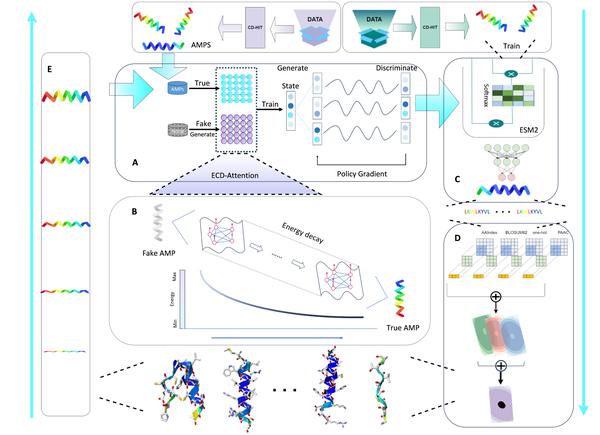import numpy as np
from transformers import AutoTokenizer, AutoModelForSequenceClassification, EsmForSequenceClassification
from transformers import set_seed
import torch
import torch.nn as nn
import warnings
from tqdm import tqdm
import gradio as gr
warnings.filterwarnings('ignore')
device = "cpu"
model_checkpoint1 = "facebook/esm2_t12_35M_UR50D"
tokenizer = AutoTokenizer.from_pretrained(model_checkpoint1)
class MyModel(nn.Module):
def __init__(self):
super().__init__()
self.bert1 = EsmForSequenceClassification.from_pretrained(model_checkpoint1, num_labels=3000) # 3000
# for param in self.bert1.parameters():
# param.requires_grad = False
self.bn1 = nn.BatchNorm1d(256)
self.bn2 = nn.BatchNorm1d(128)
self.bn3 = nn.BatchNorm1d(64)
self.relu = nn.LeakyReLU()
self.fc1 = nn.Linear(3000, 256)
self.fc2 = nn.Linear(256, 128)
self.fc3 = nn.Linear(128, 64)
self.output_layer = nn.Linear(64, 2)
self.dropout = nn.Dropout(0.3) # 0.3
def forward(self, x):
with torch.no_grad():
bert_output = self.bert1(input_ids=x['input_ids'],
attention_mask=x['attention_mask'])
# output_feature = bert_output["logits"]
# print(output_feature.size())
# output_feature = self.bn1(self.fc1(output_feature))
# output_feature = self.bn2(self.fc1(output_feature))
# output_feature = self.relu(self.bn3(self.fc3(output_feature)))
# output_feature = self.dropout(self.output_layer(output_feature))
output_feature = self.dropout(bert_output["logits"])
output_feature = self.dropout(self.relu(self.bn1(self.fc1(output_feature))))
output_feature = self.dropout(self.relu(self.bn2(self.fc2(output_feature))))
output_feature = self.dropout(self.relu(self.bn3(self.fc3(output_feature))))
output_feature = self.dropout(self.output_layer(output_feature))
# return torch.sigmoid(output_feature),output_feature
return torch.softmax(output_feature, dim=1)
def AMP(test_sequences, model):
# 保持 AMP 函数不变,只处理传入的 test_sequences 数据
max_len = 18
test_data = tokenizer(test_sequences, max_length=max_len, padding="max_length", truncation=True,
return_tensors='pt')
model = model.to(device)
model.eval()
out_probability = []
with torch.no_grad():
predict = model(test_data)
out_probability.extend(np.max(np.array(predict.cpu()), axis=1).tolist())
test_argmax = np.argmax(predict.cpu(), axis=1).tolist()
id2str = {0: "non-AMP", 1: "AMP"}
return id2str[test_argmax[0]], out_probability[0]
def classify_sequence(sequence):
# Check if the sequence is a valid amino acid sequence and has a length of at least 3
valid_amino_acids = set("ACDEFGHIKLMNPQRSTVWY")
sequence = sequence.upper()
if all(aa in valid_amino_acids for aa in sequence) and len(sequence) >= 3:
result, probability = AMP(sequence, model)
return "yes" if result == "AMP" else "no"
else:
return "Invalid Sequence"
# 加载模型
model = MyModel()
model.load_state_dict(torch.load("best_model.pth", map_location=torch.device('cpu')))
if __name__ == "__main__":
title = """🔥AMP Sequence Detector
"""
css = ".json {height: 527px; overflow: scroll;} .json-holder {height: 527px; overflow: scroll;}"
theme = gr.themes.Soft(primary_hue="zinc", secondary_hue="blue", neutral_hue="green",
text_size=gr.themes.sizes.text_lg)
with gr.Blocks(css = """#col_container { margin-left: auto; margin-right: auto;} #chatbot {height: 520px; overflow: auto;}""",
theme=theme) as demo:
gr.Markdown("Diff-AMP
")
gr.HTML(title)
gr.Markdown(
"🔥Welcome to Antimicrobial Peptide Recognition Model. See our Project
")
gr.HTML(
'''
 ''')
gr.HTML(
'''🌟Note: This is an antimicrobial peptide recognition model derived from Diff-AMP, which is a branch of a comprehensive system integrating generation, recognition, and optimization. In this recognition model, you can simply input a sequence, and it will predict whether it is an antimicrobial peptide. Due to limited website capacity, we can only perform simple predictions.
If you require large-scale computations, please contact my email at wangrui66677@gmail.com. Feel free to reach out if you have any questions or inquiries.''')
# gr.Markdown(
# """
#
# # Welcome to Antimicrobial Peptide Recognition Model
# This is an antimicrobial peptide recognition model derived from Diff-AMP, which is a branch of a comprehensive system integrating generation, recognition, and optimization. In this recognition model, you can simply input a sequence, and it will predict whether it is an antimicrobial peptide. Due to limited website capacity, we can only perform simple predictions.
# If you require large-scale computations, please contact my email at wangrui66677@gmail.com. Feel free to reach out if you have any questions or inquiries.
#
# """)
# 添加示例输入和输出
examples = [
["QGLFFLGAKLFYLLTLFL"],
["FLGLLFHGVHHVGKWIHGLIHGHH"],
["GLMSTLKGAATNAAVTLLNKLQCKLTGTC"]
]
# 创建 Gradio 接口并应用美化样式和示例
iface = gr.Interface(
fn=classify_sequence,
inputs="text",
outputs="text",
# title="AMP Sequence Detector",
examples=examples
)
gr.Markdown(
"
''')
gr.HTML(
'''🌟Note: This is an antimicrobial peptide recognition model derived from Diff-AMP, which is a branch of a comprehensive system integrating generation, recognition, and optimization. In this recognition model, you can simply input a sequence, and it will predict whether it is an antimicrobial peptide. Due to limited website capacity, we can only perform simple predictions.
If you require large-scale computations, please contact my email at wangrui66677@gmail.com. Feel free to reach out if you have any questions or inquiries.''')
# gr.Markdown(
# """
#
# # Welcome to Antimicrobial Peptide Recognition Model
# This is an antimicrobial peptide recognition model derived from Diff-AMP, which is a branch of a comprehensive system integrating generation, recognition, and optimization. In this recognition model, you can simply input a sequence, and it will predict whether it is an antimicrobial peptide. Due to limited website capacity, we can only perform simple predictions.
# If you require large-scale computations, please contact my email at wangrui66677@gmail.com. Feel free to reach out if you have any questions or inquiries.
#
# """)
# 添加示例输入和输出
examples = [
["QGLFFLGAKLFYLLTLFL"],
["FLGLLFHGVHHVGKWIHGLIHGHH"],
["GLMSTLKGAATNAAVTLLNKLQCKLTGTC"]
]
# 创建 Gradio 接口并应用美化样式和示例
iface = gr.Interface(
fn=classify_sequence,
inputs="text",
outputs="text",
# title="AMP Sequence Detector",
examples=examples
)
gr.Markdown(
"
")
gr.Markdown("Related job links in the same series:
")
gr.Markdown("
"
"
")
gr.Markdown('''📝 **Citation**
If our work is useful for your research, please consider citing:
```
waiting...
```
📋 **License**
None
📧 **Contact**
If you have any questions, please feel free to reach me out at wangrui66677@gmail.com.
🤗 **Find Me:**
 """
''')
demo.launch()
"""
''')
demo.launch()

